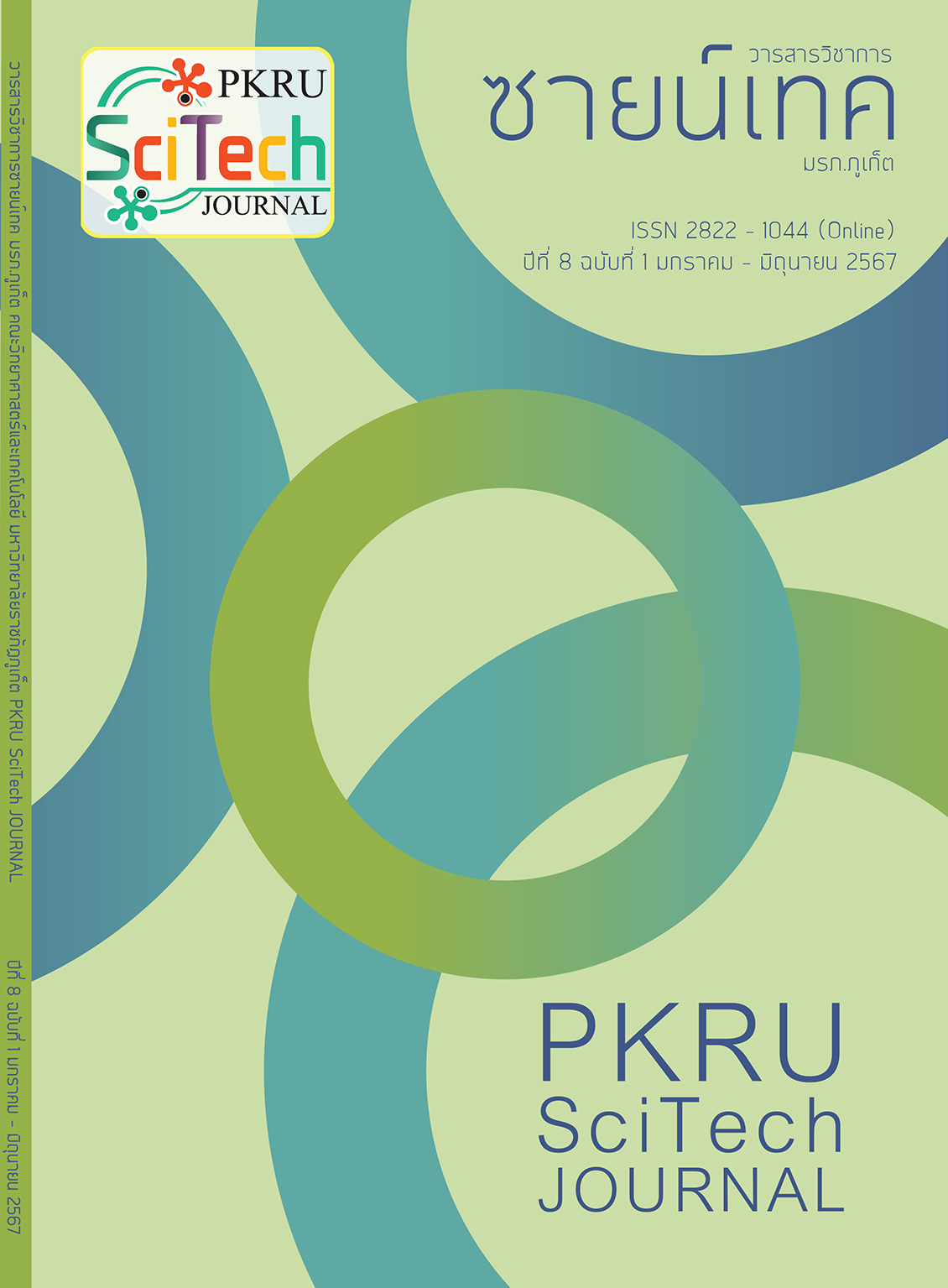Development of Thai Herbal Compress Ball Extraction Method by Using Microwave-assisted Extraction
Main Article Content
Abstract
The purpose of this study was to compare the physical properties, chemical properties, and stabilities of the extracts obtained from fresh and dried herb ingredients used in Thai herbal compress balls. The extracts were obtained using coconut oil and ethanol as solvents through the microwave-assisted extraction. The results indicated that dried herbs extracted with coconut oil and ethanol exhibited a more greenish-brown color, higher concentration, viscosity, and pH compared to fresh herbs extracted with both solvents. Moreover, they also exhibited a better aroma. Additionally, when comparing the stability, overall physical and chemical properties, it was observed that the dried herbs extracted with ethanol maintained stability under all conditions. There were no changes observed in the physical characteristics, viscosity, and acidity. These findings suggest that the dried herbs extracted with ethanol are suitable for further development into herbal products for external use in the future.
Article Details

This work is licensed under a Creative Commons Attribution-NonCommercial-NoDerivatives 4.0 International License.
- The original content that appears in this journal is the responsibility of the author excluding any typographical errors.
- The copyright of manuscripts that published in PKRU SciTech Journal is owned by PKRU SciTech Journal.
References
วิศรุต บุตรากาศ วาสนา เนตรวีระ พัฒนสิน อารีอุดมวงศ์ สุจิตรา กล้วยหอมทอง เพชรรัตน์ แก้วดวงดี และพีรนันท์ พันมงคล. (2562). ประสิทธิผลยาหม่องพริกต่อระดับความปวด ระดับขีดเริ่มของอาการปวดและองศาการเคลื่อนไหวของคอในผู้ป่วยที่มีอาการปวดหลังส่วนบนจากกลุ่มอาการปวดกล้ามเนื้อและพังผืด. วารสารการแพทย์แผนไทยและการแพทย์ทางเลือก, 17(2), 229-238.
วิษณุ กัมทรทิพย์. (2550). ปวดคอ. เวชศาสตร์ฟื้นฟูสำหรับเวชปฏิบัติทั่วไป. กรุงเทพฯ: สำนักพิมพ์เอ็น พี เพรส.
Azwanida, N. N. (2015). A review on the extraction methods use in medicinal plants, principle, strength and limitation. Medicinal & Aromatic Plants, 4(3), 1-6.
อารีรัตน์ ซื่อดี. (2560). การใช้คลื่นไมโครเวฟสกัดสารสำคัญจากพืชสมุนไพร. วารสารวิทยาการมหาวิทยาลัยอีสเทิร์นเอเชียฉบับวิทยาศาสตร์และเทคโนโลยี, 11(1), 2-4.
ซาฟาวี มะแม นัสรีย์ แวมะ มูฮำหมัดเปาซี คาเร็ง อนัส เบ็ญจมาตร ศิริรัตน์ ศรีรักษา และพิรุณรัตน์ แซ่ลิ้ม. (2565). การศึกษาความคงตัวและฤทธิ์เบื้องต้นของสารสกัดจากตำรับสมุนไพรไทย
ในการต้านเชื้อจุลชีพที่ก่อโรคบนผิวหนัง. วารสารหมอยาไทยวิจัย, 8(1), 115-128.
ศศิประภา ชิตรัตถา. (2561). ความคงสภาพของยา (Drug stability). [ออนไลน์], สืบค้นจาก https://ccpe.pharmacycouncil.org/showfile.php?file=484 (25 พฤศจิกายน 2564).
เสาวนีย์ กระสานติสุข และหทัยชนก รุณรงค์. (2549). การพัฒนาตำรับโลชั่นบำรุงผิว. [ออนไลน์], สืบค้นจาก https://pharmacy.mahidol.ac.th/th/service-research-special-abstract.php?num=7&year=2549 (7 มกราคม 2565).
พรพิมล มูลแก้ว. (2561). การสกัดสารเบต้ากลูแคนจากเห็ดนางฟ้าภูฐานด้วยคลื่นไมโครเวฟ.วิทยานิพนธ์ วิศวกรรมศาสตรมหาบัณฑิต. นครราชสีมา: มหาวิทยาลัยเทคโนโลยีสุรนารี
วิภาวรรณ นีละพงษ์ บุษบา ผลโยธิน และวันเช็ง สิทธิกิจโยธิน. (2562). การสกัดสารสำคัญจากสมุนไพรไทย: แบบผงแห้งและแบบสกัด. วารสารวิชาการพระจอมเกล้าพระนครเหนือ, 29(1), 157-166.
ภานรินทร์ ปรีชาวัฒนากร. (2560). การสกัดน้ำมันจากไพลเพื่อผลิตน้ำมันนวดไพลและยาหม่องไพลสด. [ออนไลน์], สืบค้นจาก https://it.mju.ac.th/acticleDetail.aspx?qid =753
(5 กันยายน 2565).
Pandey, A., & Tripathi, S. (2014). Concept of standardization, extraction and pre phytochemical screening strategies for herbal drug. Journal of Pharmacognosy and Phytochemistry, 2(5), 115-119.
วิภาวรรณ นีละพงษ์ บุษบา ผลโยธิน และวันเช็ง สิทธิกิจโยธิน. (2561). การสกัดสารสำคัญจากสมุนไพรไทย: การสกัดด้วยไอน้ำและการสกัดด้วยตัวทำละลาย. วารสารวิชาการพระจอมเกล้าพระนครเหนือ, 28(4), 901-910.


